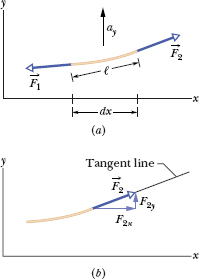As a wave passes through any element on a stretched string, the element moves perpendicularly to the wave’s direction of travel. By applying Newton’s second law to the element’s motion, we can derive a general differential equation, called the wave equation, that governs the travel of waves of any type.
Figure 16-13a shows a snapshot of a string element of mass dm and length ℓ as a wave travels along a string of linear density μ that is stretched along a horizontal x axis. Let us assume that the wave amplitude is small so that the element can be tilted only slightly from the x axis as the wave passes. The force ![]() on the right end of the element has a magnitude equal to tension τ in the string and is directed slightly upward. The force
on the right end of the element has a magnitude equal to tension τ in the string and is directed slightly upward. The force ![]() on the left end of the element also has a magnitude equal to the tension τ but is directed slightly downward. Because of the slight curvature of the element, these two forces produce a net force that causes the element to have an upward acceleration ay. Newton’s second law written for y components (Fnet,y = may) gives us
on the left end of the element also has a magnitude equal to the tension τ but is directed slightly downward. Because of the slight curvature of the element, these two forces produce a net force that causes the element to have an upward acceleration ay. Newton’s second law written for y components (Fnet,y = may) gives us

Let’s analyze this equation in parts.
Mass. The element’s mass dm can be written in terms of the string’s linear density μ and the element’s length ℓ as dm = μℓ. Because the element can have only a slight tilt, ℓ ≈ dx (Fig. 16-13a) and we have the approximation

Acceleration. The acceleration ay in Eq. 16-34 is the second derivative of the displacement y with respect to time:

Forces. Figure 16-13b shows that ![]() is tangent to the string at the right end of the string element. Thus we can relate the components of the force to the string slope S2 at the right end as
is tangent to the string at the right end of the string element. Thus we can relate the components of the force to the string slope S2 at the right end as

Fig. 16-13 (a) A string element as a sinusoidal transverse wave travels on a stretched string. Forces ![]() and
and ![]() act at the left and right ends, producing acceleration
act at the left and right ends, producing acceleration ![]() having a vertical component ay. (b) The force at the element’s right end is directed along a tangent to the element’s right side.
having a vertical component ay. (b) The force at the element’s right end is directed along a tangent to the element’s right side.

We can also relate the components to the magnitude F2 (= τ) with

However, because we assume that the element is only slightly tilted, F2y ![]() F2x and therefore we can rewrite Eq. 16-38 as
F2x and therefore we can rewrite Eq. 16-38 as

Substituting this into Eq. 16-37 and solving for F2y yield

Similar analysis at the left end of the string element gives us

We can now substitute Eqs. 16-35, 16-36, 16-40, and 16-41 into Eq. 16-34 to write

Because the string element is short, slopes S2 and S1 differ by only a differential amount dS, where S is the slope at any point:

First replacing S2 − S1 in Eq. 16-42 with dS and then using Eq. 16-43 to substitute dy/dx for S, we find

In the last step, we switched to the notation of partial derivatives because on the left we differentiate only with respect to x and on the right we differentiate only with respect to t. Finally, substituting from Eq. 16-26 ![]() , we find
, we find

This is the general differential equation that governs the travel of waves of all types.
Leave a Reply